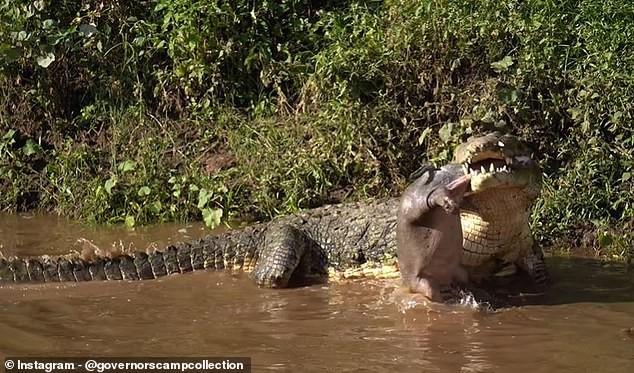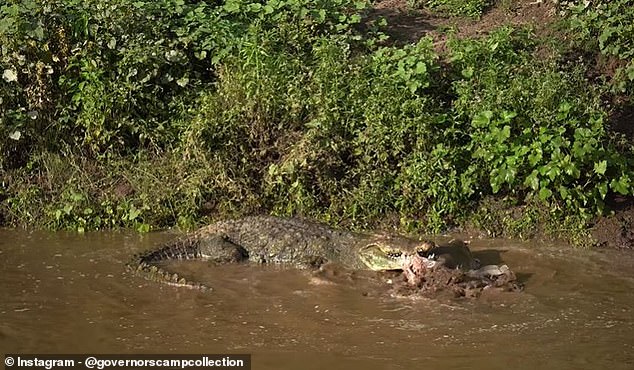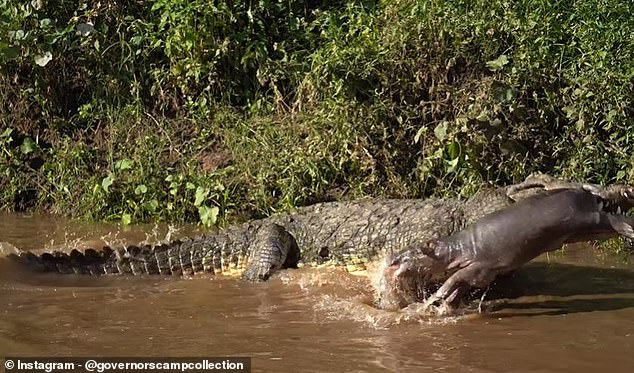Snap-solutely terrifying! Watch the moment a huge crocodile eats a baby hippo – with the umbilical cord still attached
A terrifying video has revealed the moment a huge crocodile ate a baby hippo with its umbilical cord still attached.
The footage shows the crocodile effortlessly swinging the hippo around as it flounders in the muddy waters of Kenya’s Mara River.
The crocodile was spotted by Frankie Adamson, resident photographer at Governors Camp Collective, and held the calf for 45 minutes before swimming away with its prize.
Crocodiles will rarely bother adult hippos.
However, Ms Adamson says this crocodile may have taken the opportunity to grab a quick meal, right under the mother’s nose.

A terrifying video has revealed the moment a huge crocodile ate a baby hippo – with the umbilical cord still attached
Mrs Adamson was alerted to the event by a colleague, who had noticed the crocodile thrashing.
“The crocodile already had the baby hippo in its jaws when I got closer and I was pretty sure it was already dead,” Ms Adamson said.
However, she added that no other hippos were seen in this stretch of river at the time, suggesting the calf may have been stillborn and later found by the hungry crocodile.
“This raised questions in my mind as to whether the crocodile had killed him, or whether he had been stillborn and the carcass had been torn away when I later saw that the baby’s umbilical cord was still attached,” Ms Adamson said. Living Science.
Ms Adamson says it is widely believed that a crocodile would not threaten an adult hippo for fear of being killed, but adds that they are clever opportunistic hunters.
If given the opportunity, a crocodile could possibly take a live baby hippo from its mother.
“However, it is something I had never seen with my own eyes,” she added.

Crocodiles shake their catches to kill them, but also to tear them into smaller pieces that they can swallow

It is still not clear whether the crocodile captured the hippopotamus itself or whether it managed to leave the stillborn behind.
As you can see in the video, crocodiles will roll and shake their prey to kill them, but also to tear them into pieces small enough to eat.
The footage shows the crocodile almost tearing the hippo’s hind leg with the force of its bite before disappearing into the water.
A hippopotamus calf can weigh up to 45 kg, demonstrating the raw power of these ancient predators.
In an Instagram post, Governors Camp Collection wrote: ‘It is certainly not often that these ruthless and most efficient apex predators take baby hippos from their mothers – in fact, as opportunistic as crocodiles are – they will often avoid hippos because they know how aggressive an animal is. an angry hippo could be.”
Adult hippos can grow up to five meters in length and weigh between 1360kg and 4499kg, making it easy for them to kill an adult crocodile.
The type of crocodile seen in this video is a Nile crocodile, or Crocodylus niloticus, which averages between 3.9 and 4.2 meters in length and weighs about 410 kg.
However, the largest Nile crocodiles can grow up to five meters in length and weigh up to 600 kg.
They are widespread in sub-Saharan Africa and can be found in the Nile Basin, Madagascar and in rivers and swamps in the region.
In general, Nile crocodiles feed on birds, fish, reptiles and larger mammals such as antelopes, wildebeest and gazelles.
They have also been known to take on other carnivores, such as cheetahs and lion cubs, if given the chance.
Like ambush predators, these enormous carnivores wait motionless, hidden in the water before unleashing an explosive attack.
They are also the fastest of all crocodiles on land and can reach speeds between 30 and 35 kilometers per hour.
